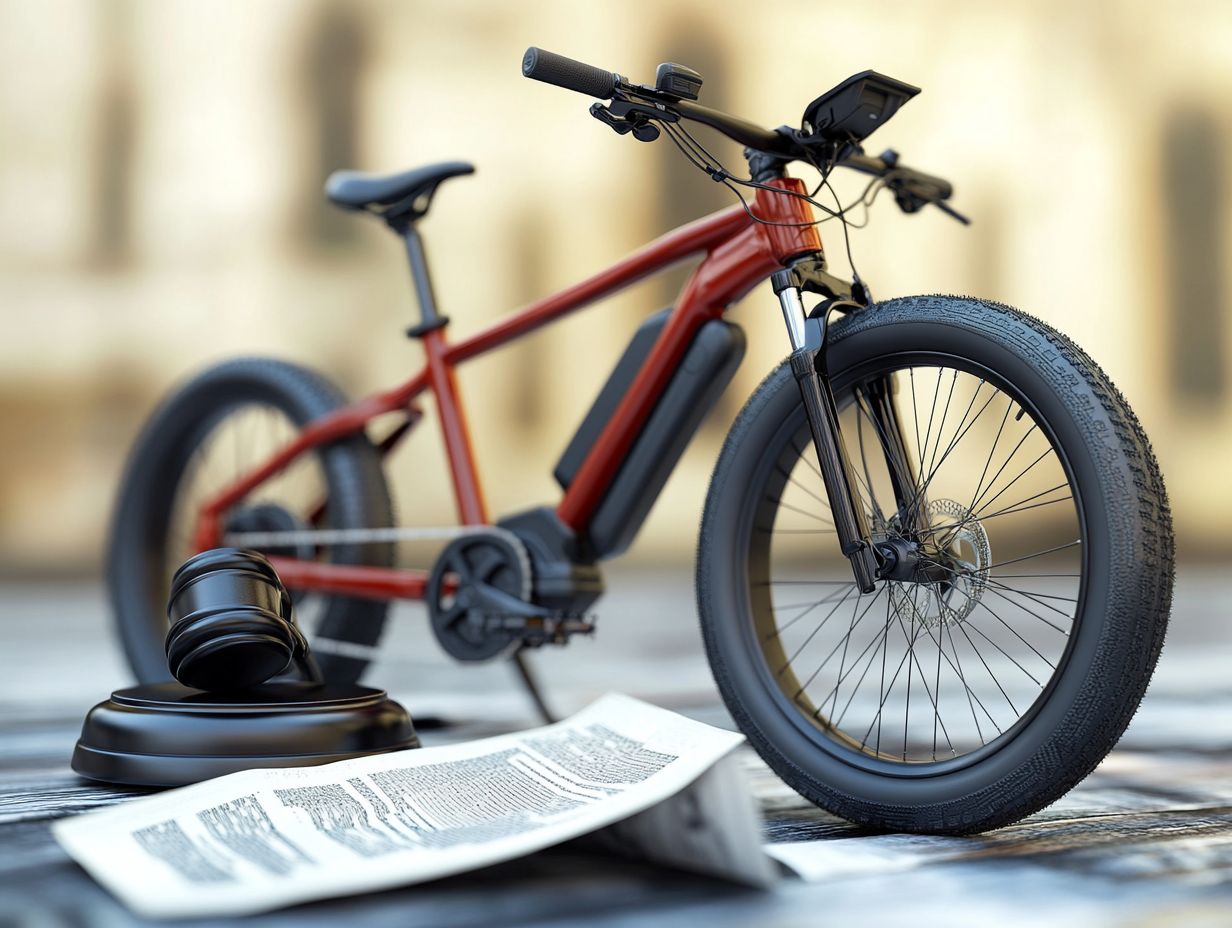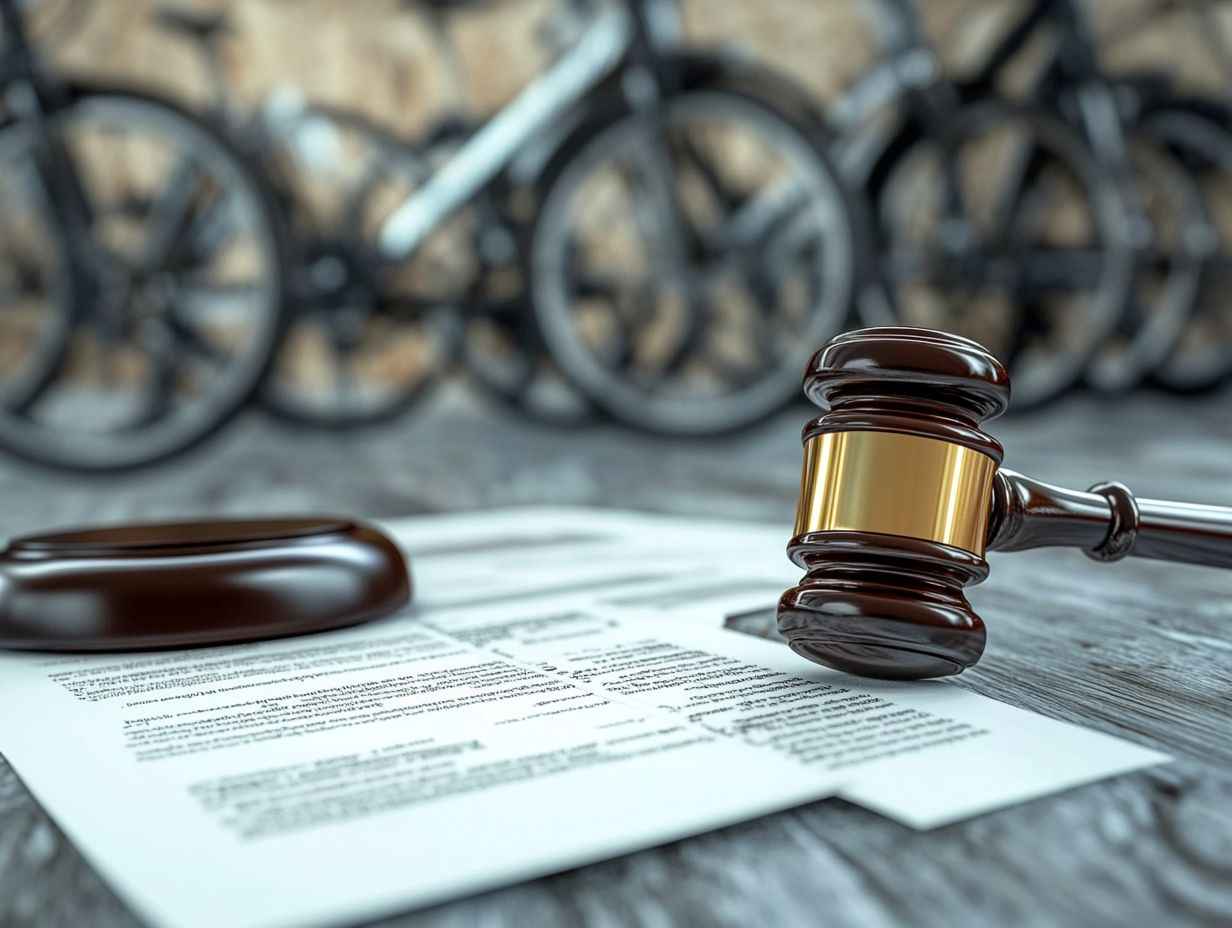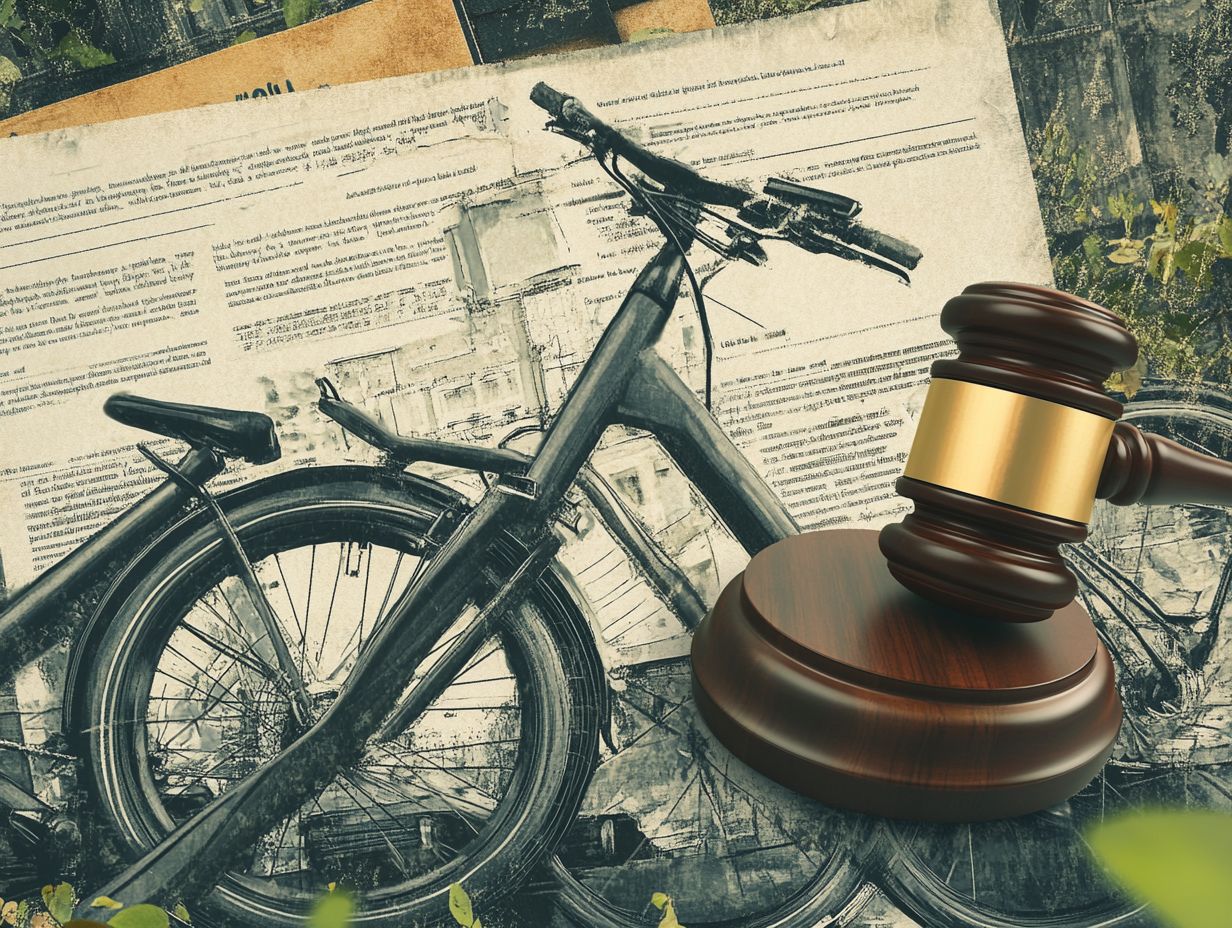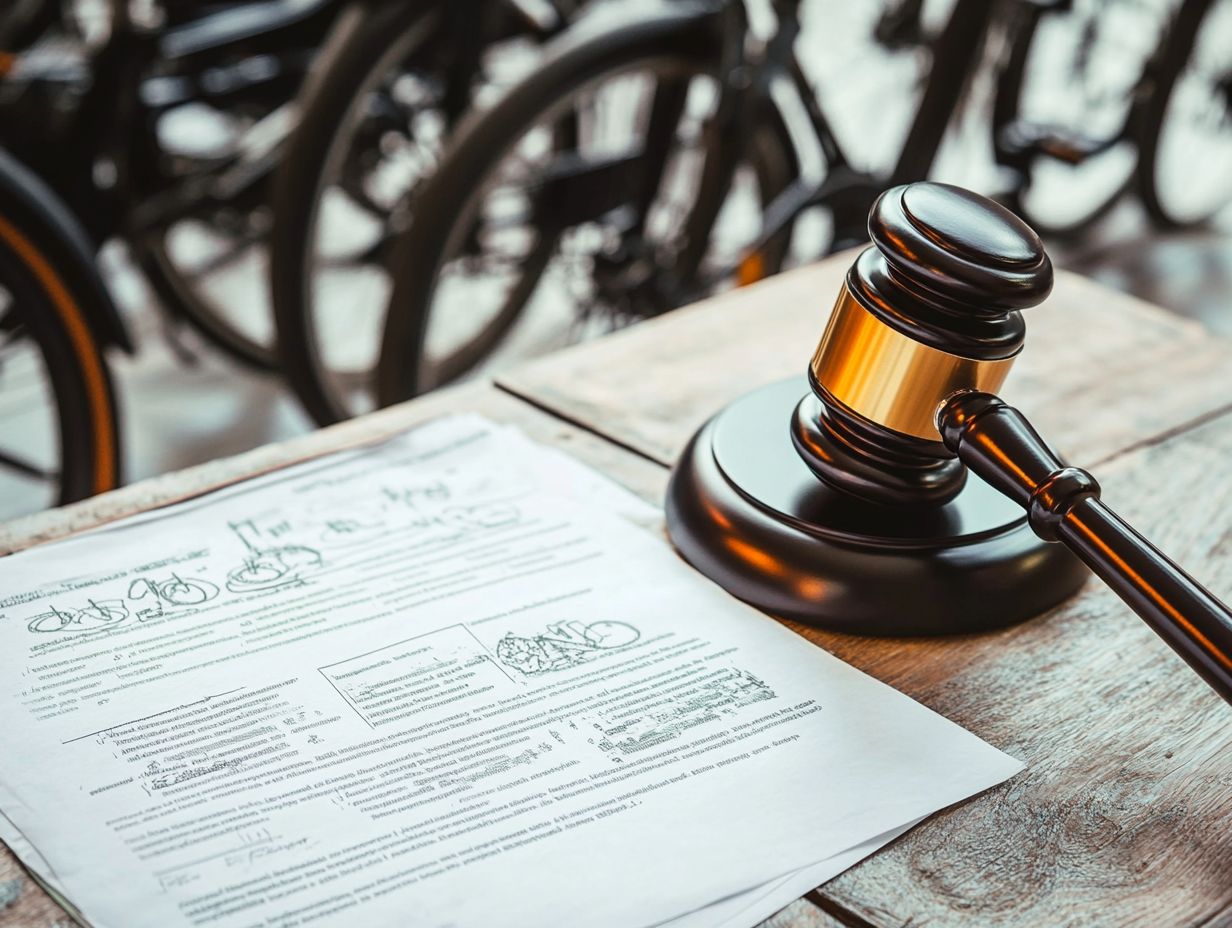A Quick Reference for Electric Bicycle Legal Terms
Electric bicycles, also known as e-bikes, are revolutionizing your commute by providing an exceptional combination of convenience and eco-friendliness.
Get ready to dive into the world of e-bikes and discover everything you need to know! However, exploring the realm of e-bikes can feel overwhelming with many terms, classifications, and regulations, including local authorities’ guidelines. This article will break down essential terminology, explore various types of electric bicycles, and clarify the laws and safety requirements you need to know.
We ll also debunk common myths surrounding e-bikes, ensuring you re well-informed and fully prepared to ride with confidence.
Contents
Key Takeaways:

- Classification and definitions of electric bicycles vary by state and country, so it’s important to research local laws and regulations before purchasing and riding.
- Electric bicycles must meet the same safety requirements and equipment regulations as traditional bicycles, including wearing a helmet and complying with traffic laws.
- There are many misconceptions about electric bicycles, such as their speed and power capabilities. It’s essential to educate yourself and others to promote safe and responsible use.
Understanding the Terminology
Understanding the terminology surrounding electric bicycles is crucial for you, whether you’re a user or part of local authorities in New Jersey, California, or Florida. These electric-assisted bicycles are categorized into three classes: Class 1, Class 2, and Class 3, each defined by specific regulations and motor capabilities.
Organizations such as PeopleForBikes advocate for clear definitions and safety standards, ensuring that e-bikes can be safely integrated into your community and comply with local regulations in states like Texas and Oregon.
Types of Electric Bicycles
Electric bicycles, commonly known as e-bikes, come in various types, primarily classified as Class 1, Class 2, and Class 3. Each class has unique features and functionalities designed to cater to different riding styles and regulatory requirements.
By understanding these classifications, you can select the perfect electric bike that complies with local regulations, informed by electric bicycle regulations: a global overview, and enhances your riding experience, ensuring that each ride is both enjoyable and fulfilling.
Classification and Definitions
Understanding the classification of electric bicycles is essential for grasping their legal status and proper use. E-bikes fall into three distinct categories: Class 1, Class 2, and Class 3, each defined by their operational characteristics and the level of motor assistance they provide.
Class 1 electric bicycles, including models designed for safe commuting, offer pedal assistance only up to a speed of 20 mph. Many riders prefer these for commuting and leisurely rides, as they provide a helpful boost and encourage physical activity.
Class 2 models come equipped with a throttle that can propel the bike to the same speed without the need to pedal. This accessibility makes them appealing to a broader audience, including those who might face challenges while cycling.
Class 3 e-bikes can reach speeds of up to 28 mph. These are ideal for experienced riders seeking efficient transportation, but they often come with specific restrictions regarding where they can be used.
In New Jersey, being aware of these classifications is particularly important, as local laws dictate compliance with speed limits, registration, licensing requirements, and operational features. This ensures safety and order on shared pathways, allowing everyone to enjoy the ride.
If you’re eager to learn more about e-bikes, consider joining a local cycling community or exploring further resources!
Laws and Regulations for Electric Bicycles

Navigating the intricate landscape of laws and regulations surrounding electric bicycles, including e-bikes, is imperative for riders like you. Ensuring compliance with both local and national traffic laws and motor vehicle laws will keep your riding experience smooth and trouble-free.
In New Jersey, as an electric bike user, you must adhere to specific safety standards. This may include registration and licensing, depending on the class of your e-bike. To ensure your e-bike is equipped properly, check out the essential guide to electric bicycle components. You also need to follow bicycle regulations. Local authorities are committed to fostering a safe riding environment for all cyclists, and your adherence to these regulations contributes to that goal.
Local and National Guidelines
Local and national guidelines play a crucial role in shaping how electric bicycles can be used. Distinct regulations set by local authorities ensure your safety and adherence to traffic laws.
Take New Jersey, for instance. Here, local ordinances specify safety standards that cover helmet use, speed limits, and bicycle paths. These may differ from broader national guidelines. Local nuances can create a unique riding experience. While some areas might allow higher speeds on electric bikes, others enforce strict limits in urban environments. For a deeper understanding, refer to Understanding Electric Bicycle Safety Regulations.
It s essential for you to stay informed about the rules in your area. This awareness helps you avoid fines and ensures a safe ride. It s not just about personal safety; it s about fostering a culture of respect on the roads.
Safety Requirements for Electric Bicycles
Electric bicycles require safety measures, including the mandatory use of helmets. You also need to adhere to specific riding regulations designed to ensure a safe experience for all cyclists.
By implementing these safety standards, you not only protect yourself but also contribute to creating a more secure environment on the roads and bicycle paths for everyone.
Equipment and Riding Regulations
Riding regulations for electric bicycles emphasize the use of safety gear, like helmets, to enhance your protection while navigating diverse terrains and adhering to road rules.
You should also consider additional protective gear such as gloves and knee pads. These can significantly reduce your risk of injury should an accident occur. Many regions, including Pennsylvania and South Carolina, require e-bike users to follow specific riding rules. This includes staying within designated bike lanes or paths and observing speed limits. For more information on specific regulations, familiarize yourself with the key legal considerations for electric bicycle riders. This is for your safety and for the well-being of pedestrians sharing the road.
Neglecting to comply with these regulations could lead to fines or restricted access to bike lanes. Understanding the classification of electric bicycles is crucial in fostering a culture of shared responsibility on the roads.
Common Misconceptions About Electric Bicycles

Despite the rising popularity of electric bicycles, several misconceptions still linger. These often cause confusion regarding their classification as motorized bicycles, or bicycles that have a motor to assist with pedaling, and their adherence to road regulations, including age restrictions in various states.
Grasping these myths is crucial for you as a potential rider. This understanding enables you to make informed decisions and fully embrace the benefits of e-bikes in a responsible manner.
Clearing up Confusion and Myths
Clearing up myths about electric bicycles is vital. It promotes responsible riding and clarifies their legal status as motorized bikes.
People often think e-bikes zoom at motorcycle speeds. In reality, most e-bikes have speed limits of 20 to 28 miles per hour based on their type.
Some traditional cyclists may see e-bike riders as less committed to fitness. However, e-bikes offer a solution for those facing physical challenges, promoting inclusivity.
Addressing these myths helps create a safer community and enhances everyone’s cycling experience, ensuring inclusivity for all riders.
Frequently Asked Questions
What is an electric bicycle?
An electric bicycle uses a motor for power. You can ride it like a regular bike or with motor assistance.
What is the legal definition of an electric bicycle?

In most areas, an electric bicycle is a two- or three-wheeled vehicle with working pedals and a motor that outputs no more than 750 watts.
Do I need a license to ride an electric bicycle?
In most cases, no. Electric bicycles are generally classified as bicycles and do not require a license to operate. Always check your local laws to be sure.
What is the maximum speed of an electric bicycle?
The maximum speed of an electric bicycle varies by area, but it is usually limited to 20-28 miles per hour.
Are there any age restrictions for riding an electric bicycle?
Generally, there are no age restrictions for riding an electric bicycle. However, some countries may have laws stating a minimum age requirement.
Do I need insurance for my electric bicycle?
In most cases, no. Electric bicycles are typically classified as bicycles and do not require insurance. Always check your local laws to be sure.
Ride safely and explore the joys of e-biking!





